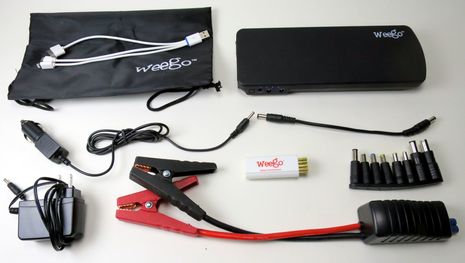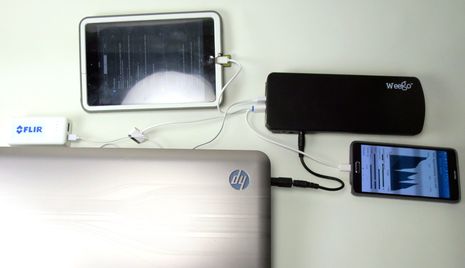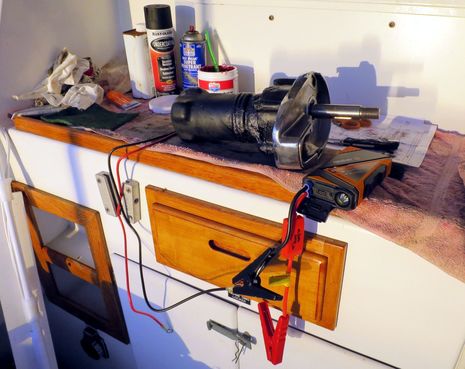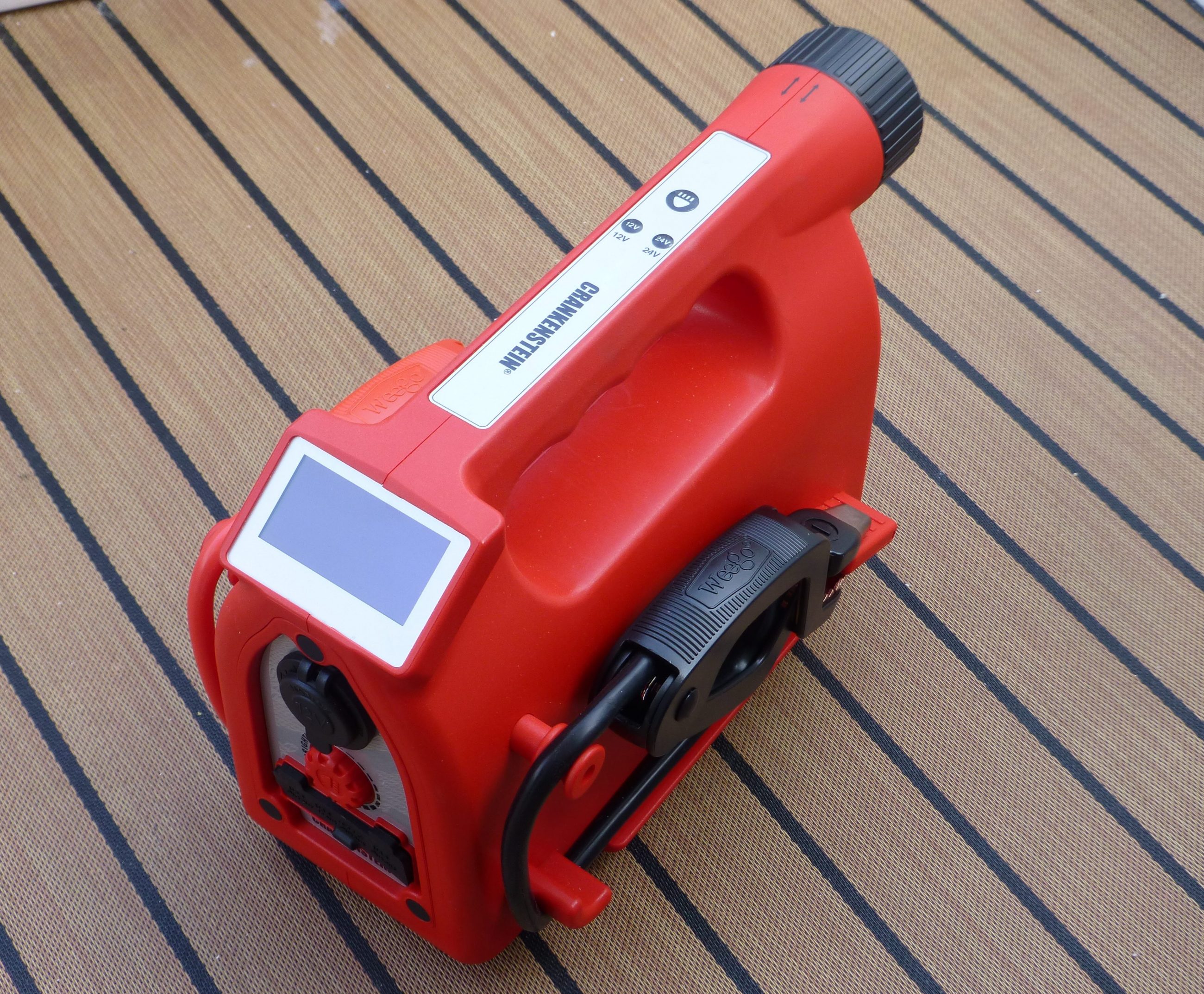Testing Lithium Ion engine jumpers (plus), from Weego and Cyntur

Most boaters will not experience the benefits of a Lithium Ion main battery bank any time soon, but nearly instant gratification is possible with a portable Li Ion charger pack, some of which can even jump start a small diesel engine. Brands and models are proliferating like fruit flies, but I’m particularly keen on the WeeGo Jump Starter Pro above, which I’ve been testing for a couple of months. It is a veritable Swiss Army knife of an on- or offboard power source…
 While the top photo shows the complete WeeGo Pro kit, this photo illustrates how hard it can work. Since one of the USB ports outputs 2.1 amps, I was able to top up both my iPad Mini and Samsung Note4 using the included split cable with Lightning and micro USB connectors. And remember that iPads don’t like some USB chargers and few power packs come with Apple connectors (apparently because you-know-who makes licensing difficult).
While the top photo shows the complete WeeGo Pro kit, this photo illustrates how hard it can work. Since one of the USB ports outputs 2.1 amps, I was able to top up both my iPad Mini and Samsung Note4 using the included split cable with Lightning and micro USB connectors. And remember that iPads don’t like some USB chargers and few power packs come with Apple connectors (apparently because you-know-who makes licensing difficult).
Meanwhile I’m using the 1 amp USB port to top up that small (FLIR gifted) power pack that could have yet another USB device charging off it. But the particularly useful thing for boaters trying to use a laptop on a 12v boat is the WeeGo’s 19v (and 12v) outputs. This could save you having to buy and manage a dedicated or universal 12v laptop charger for your boat. Unfortunately though, laptop power connectors are extremely varied and none of WeeGo’s adaptor tips work with my current HP Pavilion (though WeeGo is looking into alternative sources).
The Pro’s 18000 mAh Li Ion battery would power that setup for quite a while, I believe, and you could plug its 12v charger into the boat and thus keep everything continuously topped up with the WeeGo ready to swing into jump start action.
I’ve had a hard time finding a realistic jump start situation, but before I explain the photo above, let me express deep shame before the boat deities for how badly I’ve ignored L’il Gizmo since her big sister came into my life. So it wasn’t a big surprise, or the WeeGo’s fault, when the Honda 40 wouldn’t turn over at all (and it’s now in the hands of a real mechanic).
The test was impressive nonetheless. That old yellow battery was barely alive — showing 10.5 volts with no load — but the Pro happily ran the Honda’s tilt hydraulics up and down until my finger got tired pushing the buttons. I didn’t even see the Pro’s five blue status LEDs show a drop in charge level before concluding that the relatively small Lithium Ion battery has a LOT of gumption. The claimed maximum jump capacity of a 4.8L diesel (about 140 horsepower) or “most gas engines” — or in other words 300A current, peaking to 600! — seems realistic, though Li Ion punch-to-mass ratio takes some getting used to.
 All the Lithium Ion power packs seem to be manufactured in China, but I’m fine with that if someone is making sure they’re made well. WeeGo is definitely the right sort of company for that, as well as solid distribution and customer service. In fact, WeeGo has a particular interest in the boating world and introduced the WeeGo line at the Miami show. I like the concept of a longterm family business with their own testing lab making sure a product like the Pro is safe. Afterall, if you mess up with those battery clamps, you’re apt to see more than just a spark, but the WeeGo Jump products have internal “over-charge, over-discharge, over-load, over-current, and short-circuit protection,” while the clamps themselves have a fuse and a diode which protect against over-current and reverse polarity. (That fuse, by the way, has to be replaced by WeeGo, which is even more reason to clamp first and then activate.)
All the Lithium Ion power packs seem to be manufactured in China, but I’m fine with that if someone is making sure they’re made well. WeeGo is definitely the right sort of company for that, as well as solid distribution and customer service. In fact, WeeGo has a particular interest in the boating world and introduced the WeeGo line at the Miami show. I like the concept of a longterm family business with their own testing lab making sure a product like the Pro is safe. Afterall, if you mess up with those battery clamps, you’re apt to see more than just a spark, but the WeeGo Jump products have internal “over-charge, over-discharge, over-load, over-current, and short-circuit protection,” while the clamps themselves have a fuse and a diode which protect against over-current and reverse polarity. (That fuse, by the way, has to be replaced by WeeGo, which is even more reason to clamp first and then activate.)

I also tested a Cyntur JumperPack mini which claims 250 cranking amps from its 12000 mAh Li Ion battery. It, too, seems quite well made and it’s less expensive than the similar 12000 mAh WeeGo Heavy Duty model, though also less versatile as a device charger.
I still haven’t run an engine battery dead enough to test either product’s jump start abilities — call me if you’re stuck somewhere nearby — but I did use them to test the SL Sprint 1000 anchor windlass I reassembled on Gizmo before leaving North Carolina. Replacing the motor and some gearbox bearings became an epic repair involving starter shops in both Maine and NC (and a parts supplier in the UK), and it was great to see it run again before reinstalling it on the bow. The WeeGo Pro was a little easier to use because I could switch the jump power on and off (and it may have more levels of protection), but both packs seemed willing to turn the windlass for a long time and I think they might be able to pick up Gizmo’s anchor. Lithium Ion technology is pretty impressive in this form and very available.















Don’t you just love marketing spin doctors!
18000 mAH always used to be 18AH in my day.
Derek
Yes, Derek – but 18000 is obviously a MUCH bigger and impressive number than 18..:-)
More silly math tricks.. 18aH divided by 300 amps (rated start current) = .06 hours = 3.6 minutes — which should EASILY start an engine in good shape, so this thing ought to work if it can really source that much current.
I’m more worried about what happens when someone accidentally shorts those two jumper clips. If we assume they’re fused at 600 amps (the “peak” rating) the arc that will result from contact will be substantial (most arc-welders are well under that current) and likely to do damage to not only the clips, but any metal comes in between – plus the potential for eye injury (wear your safety glasses – PLEASE!). It is good to see that they are much better insulated than the average automotive “jumper cables”. One also wonders what the thermal runaway characteristic is of those cells (a real bugaboo of lithium cells in the past).
Ben, did you check the RFI generated by the 12V charger or 19V power supply? I’ve found that 12V – 19V laptop “mobile power supplies” can generate substantial levels of interference, especially on HF, which causes issues if you use them whilst conducting a Sailmail session, or downloading WXFAX charts.
Their website says that they have “safety protection” — overcurrent, automatic shutdown, etc.
I’m not sure it that would preclude a bad “spark” and maybe some damage, but it would seem to protect against a “melt down”?
I bought my boat about 18 months ago and it came with a substantial house bank but no start bank. I’m loath to give up limited storage space to a permanent start battery so I’m in the process of wiring an Off/1/Both/2 switch into the starter circuit with #2 acting as an emergency jump start connection for one of these lithium packs. I’ll report back on how it works.
I don’t need the jump start for my main engine. How ever to have a source of 12 volts when I am working on electronics, pumps, motors, etc. at my work bench (the salon table) appeals to me). Lastly I have occasionally not been able to charge my laptop, cellphone, or tablet.
This may become a future purchase, or better yet a gift for fathers Day.
Pat Harman
OK, so I got off my butt and checked out the websites..:-) The Weego site is very informative, and allows you to download the manual as well as the advertising brochures, etc. If you blow the fuse (in the black clamp) or blow the reverse-protection diode (in the red clamp), you are supposed to buy a new clamp set ($15 for the model Ben has). Seems reasonable, and it does allow you to do the whole hookup and make sure it’s right before energizing, which is a GREAT idea.
It is amusing to note that the nice picture they use showing someone about to hookup their unit to their car battery has them about to hook it up backwards (red to vehicle frame, black is headed for the positive battery terminal – must have been during the “blinding flash” portion of their testing..:-)
I also note an odd math discrepancy – the charging device – AC or DC – is supposed to be 14V at 1amp – but it will charge an 18 amp-hour battery in 5 hours or less?
The Cyntur site is nowhere near as informative, though I did note that they are also introducing (real soon now) an 18 aH unit like the Weego – and their units are indeed substantially cheaper (though it does seem to lack the ability for 12V charging). They also haven’t paid the licensing fee for their website software – and their web site tells you that down at the bottom..:-)
All in all, these look like useful things – just what I need, more stuffe to find a place for in here.
Using a Li-ion jump start battery as a start battery is worth looking into. However, using a Off/1/Both/2 switch is not a good idea because that ‘Both’ position would parallel batteries of differing chemistry and different charging requirements.
I noticed on the web that Porsche was looking at using Li-ion start batteries for cars which shut down the engine at stop lights.
BTW, what AWG size are those battery cables? Are they really rated for high start currents?
There seems a mismatch between charging capability and battery capacity, that would not be apparent except for the product having a secondary purpose of running laptops including packaging with various laptop charging tips.
Where as a Dell laptop would have a 5800 mAhr battery and a 65 watt charger (with an option for a 90 watt charger), this product has a capability three times larger (18000 mAhr) battery and just a 14 watt charger.
Perhaps the charging capability is incorrectly listed, as was pointed out by Hartley the specs show 5 hours to charge.
It’ll never be in the “both” position except transiently, as I switch over between the house bank and the starter. The starting plan is as follows:
1. Switch from the 1 (house) position to the 2 (jump) position.
2. Connect the jump battery as directed by the manufacturer
3. Start the engine
4. During the 90 second charge start delay I’ve programmed into my Balmar regulator, switch back to the 1 (house) position.
5. Disconnect the jump battery.
It should be safe to swap steps 4 and 5 but if you miss the 90 second charge start delay, the alternator diodes will fry so I think it’s better to do it this way.
BTW, the cables on my jump battery are 8 AWG and the total length is less than 2 feet. This is the unit I have:
http://www.amazon.com/gp/product/B00MH4663C?psc=1&redirect=true&ref_=oh_aui_detailpage_o02_s00
Looks like my last comment got truncated. {fixed now – ed} It was supposed to say that the total battery cable length is under 2 feet.
The link goes to the particular starter I purchased. From what I’ve been able to tell, all the larger starters use the same cells in the same number and are about 16.5AH actual capacity, despite some specsmanship that leads to claimed capacities of 18AH.
Today I learned these battery cases are not particularly robust and that the elastic band holding them in the soft side carrying case is weak.
Mine is about 18 months old. Upon taking mine out of the case today it dropped about three feet to a hardwood floor. The case split open exposing the internals. I got it back together after a little difficulty and proceeded to charge the battery. It seemed to charge properly but the little flashlight no longer functions.
I was preparing for a fishing outing and like to have my little jumper along. If it’s needed (unlikely) I hope it works. If I have enough time I’ll test it and recharge before leaving.
Butch, I think you mean the Cyntur, right? Actually, I thought the product and its carrying case seemed solid. The WeeGo only comes with a bag.
Saffy, I think your project sounds really interesting and hope you’ll keep us updated, but…
Dan made a good point about the WeeGo’s charging limitations. In fact, I don’t think it’s getting much or any charge when using the 12v input unless the engine running or the solar panels are cooking. In other words, it seems to charge slowly at 13+ volts and very, very slowly at, say, 12.4v.
So my concept of using the WeeGo as a constant power source for a laptop may be somewhat flawed. But I will ask if what I’m seeing is “normal.”
Ben,
My little battery is labeled Anti Gravity. I believe there are a couple of manufacturers and several company labels in use.
Butch, there seem to be two models of Antigravity li ion jump start batteries…
http://antigravitybatteries.com/microstart/
…and neither one is like either one of the battery packs discussed in this entry. Even if they were exactly the same items coming out of a Chinese factory, they’re still not the same when distributed under different brands because that can also mean different quality control, customer service, etc.
One of the points I was trying to make in this entry is that all these power packs are not the same (just like LED bulbs and fixtures). There’s quite a lot of technology involved, and precision manufacturing, and of course “middle men” good and bad.
Sorry, mate, but your original comment seems quite irrelevant.
Hi Ben,
I had a chance to try out the JS 18. It was to start a 2001 Lexus with a 4.3 Liter V8. The battery so low that the wireless key lock wouldn’t unlock the door.
Short version: The engine sprung instantly to life surprising my skeptical engineer friend who was my helper and verifier of the test.
Conclusion: Two thumbs up!
Cool, my “power guy” — http://goo.gl/K4cMR — weighs in. Alden, isn’t it strange to see so much power come from something so small? We made it to the age of Li Ion 😉
But please try charging the JS 18 using an “at rest” 12v source, like your parked car. I’m curious if you see very slow progress.
Ben,
Yes, probably irrelevant. Meant as simple warning to use a bit of care in handling the batteries.
Eye-opening but mysterious. A little jump-start pack sure makes my start battery look ridiculously big and heavy, because it was probably spec’d for cranking amps, not for Amp-hour capacity. To match the amp-hour capacity of the typical jump-start pack would take on the order of about 10 AA cells! That ability of Li-ion to deliver current is very impressive, which makes me leery about how casual the ads are about the dangers of high-current voltage sources, since it’s another way of playing with fire.
ABYC may not approve of running up to 600 Amps through 8 AWG cables 🙂 I know it’s just for seconds at a time and it doesn’t usually take that much current to run a starter motor.
The mystery is the lack of details. When a jump start pack is used for that purpose, are they delivering 19 Volts to your starter? In which case, disconnecting your electronics for “safety” reasons would be a good idea. Although, if there is a diode in the jumper cables, maybe they’re only sending it 18 Volts or so…
And charging a 19 V battery from a 12 V source? The extra electronics involved in that might limit the charge rate for cost reasons. For a 5 hour charge you would expect at least 4 Amps …
My Amp-hour comparison wasn’t fair because the voltages weren’t comparable. So multiply the number of AA cells needed by ten again.
As for charging, each Li-ion cell is around 4 Volts depending on the chemistry, so charging from 12 Volts is possible, but I would still like to know how they do it. Charging is critical.
http://batteryuniversity.com/learn/article/charging_lithium_ion_batteries
Well, I found out that the car charger is “is rated at 14V” which probably explains the behavior I’m seeing.
Sorry for the delay in reporting back, I still have to wire in the switch and clamp stud. I was going to do it last week but the weather was so nice…
Anyway, FYI the little AC wall wart that came with my charger is 14.5V.
Cool! So I finally get home — those last legs were harsh — to find my Ford Escape completely dead after 6+ weeks unused. But the Weego JS18 — though not fully charged — jump started it instantly first try. Nice.
And I have so much other testing to report on, but need more rest and family time first.
(Incidentally, I like the Escape a lot but it’s had an ongoing problem with the battery going flat from lack of use. I even replaced the battery it came with in 12/13 with a bigger amp hour model. I was also told that the recall updates the car got in January would help with the issue but clearly I need to leave a trickle charger or solar panel on it if I leave it again for several weeks or more.)
It is reasonably clear that the NTSB should mandate that cars/trucks/boats should have a high capacity plug-in socket so that there is no need for users to handle live alligator clips carrying the sorts of amps these units (and other cars etc.) can deliver.
A one-way only socket/plug setup, (something like a marine-style 3 prong extension) together with a switch in the hot-line side would prevent users from frying their electronics or from blowing up a battery, or just frying themselves as hot misconnections could not occur. It would be interesting to see some statistics on injuries sustained by users attempting to use standard jumper cables and failing. And statistics on the annual total of damage from those failures.
If a standard were promulgated, it would not be difficult nor expensive to retro-fit the socket to any car. Female socket in the vehicle, as it is presumed to be hot, and the socket prevents inadvertent contact. The cable is male/male with a push and hold ‘on’ switch on the hot wire side, so ground/neutral are made when the cable is plugged in, before ‘hot’ is energized. Diodes not needed and fuses optional in the cable.
But then again, this is all too reasonable to be implemented.
I finally got a chance to wire up the jump start terminal and switch today. I removed my starting battery when I first got the boat and have just been using the house bank to start the engine (long story why). Today, I put a Off/1 (house)/All/2 (jump) switch between the house bank and the starter with the 2 (jump) switch terminal wired to a Blue Sea 3/8″ stud mounted near the battery ground bus.
One thing I like about the Bolt jump starter design is that the starting procedure is exactly what you’d intuitively expect. You isolate the house bank from the starter by putting the Off/1 (house)/All/2 (jump) switch in the 2 (jump) position, you attach the jumper cables to the ground bus and the dedicated positive jump stud, you turn on the starter and plug the cables into, and start the engine as you normally would. There’s no special “boost” button or other counterintuitive procedural steps.
For my initial testing, Bolt jump starter was fully charged (all four segments of the charge status indicator lit) and started the motor without hesitation. There was absolutely no qualitative difference in the cranking speed or time to ignition versus my 800AH house bank. The charge status indicator didn’t change after starting. One of these days I’ll see how many starts I can get out of a single charge but I’m quite pleased with the performance so far.
Thanks, Saffy! What size engine do you have, and which model of Bolt Li Ion jump pack?
Also, I think we should note that a battery switch set up to also switch alternator output should not be used like you are, right?
Finally, I like the booster button on the Weego jump accessory as it means I can set up the clamps before applying power and also get a check that I got the polarity right. As I understand it, blowing the fuse or diode in the clamp accessory requires a factory repair or replacement but does make the device safer. I’m not positive but think that all these Li Ion jumpers have a fuse that is not user replaceable.
Hi Ben,
The engine is a Yanmar 4JH3-HTE. It’s a four cylinder 2.0L turbocharged unit that puts out 100Hp/75kW. Mine’s got 4400 hours.
The lithium unit is from Bolt and is the biggest one they make (16.5Ah), rated for pickup trucks and the like. You can find it here:
http://www.amazon.com/gp/product/B00MH4663C?psc=1&redirect=true&ref_=oh_aui_detailpage_o02_s00
I agree that it’s far better to have the alternator on a separate circuit from the starter. In my case, the engine alternator is secondary to a high output alt I’ve got mounted in front of the engine on its own circuit. It’s a bear to get to the starter and engine alt to re-wire, so I just left them wired together.
Do Not buy the Weego. Poor quality product and doubtful warranty support. I bought their top of the line JS18 from Amazon on 2/4/2016. I’ve kept it charged and take it with me on occasional boat trips as a backup, but mostly keep it on the garage. I had not used the Weego for about 2 months but when I tried to use it today I found it bulged out of its crappy plastic case and unusable. Temperature in my garage never gets over 90F so what gives. This product does not deserve its billing as an emergency, get you out of trouble, piece of kit. In addition, if you go to their website, you cannot find a phone number for customer service. This is always a red flag which I should have checked before hand. Not only that, but they don’t even have an online trouble ticket/warranty system or something of the kind, a second red flag. Your only option is a web mail support request with no accountability. Third red flag. Maybe this outfit will do right by me, but if I could do it over I’d steer well clear. Be warned.
My biggest disappointment was the shortness of the leads and the small and weak springs on the battery jumper accessory.
The new model,the Starter 44, appears to have a better clamping system but has a smaller punch than my current JS 1800.
I have used my JS 1800 many times on my 2004 Volvo here in Maine(gotta track down that leak someday!), as well as assisting stranded motorists I have come across. People have been amazed to see so much power in such a small package.
Hopefully you will get some satisfaction from the company. The website says 18 month warranty.
Hi Alex, I’d also like to see a Weego support phone number (and it’s not in the manual either), but I think it’s much less of a red flag in 2016 than it used to be. Also, I do find comfort in the way Weego has personalized their web contact page:
https://myweego.com/contact-us/
Did Joey or Watson get back to you in 1-2 business days?
Like Alden my test JS 1800 has held up fine, and I suspect that Weego will honor the 18 month warranty.
Alden, the new Weego 44 may be more powerful than you think because they changed the measuring criteria. Here’s the skinny from Weego:
“The capacity is listed in Wh instead of Ah because of shipping regulations passed onto li-ion products – they want to see the overall Wh of the product instead, so we obliged
The 44 is 41Wh, and your math is almost correct! The nominal voltage of the battery pack is actually 11.1V which gets bumped up to 12V for jump starting.
Real capacity at 11.1V is 3700mAh; however, we measure capacity from the 5V USB port (as does everyone in the industry), since most consumers understand how capacity will affect the number of phone charges they will get as opposed to how many jump starts they will get.
So, when using the USB port the capacity is actually 41Wh/5V = 8,200 mAh”
I could care less about how the “power” is calculated. Reminds me of a book presented in Statistics class, oh so long ago, “How to Cheat and Lie with Statistics”. This is the state of advertising today. The bottom line to me is cranking balls! The Standard claims to start gas to 4.6L and diesel to 2.4L. The 44 claims gas to 6.4L and diesel to 3.2L. The Heavy Duty claims gas to 6.4L and diesel to 3.2L. The Professional claims gas to 9.5L and diesel to 4.8L. Need I say more? Hey Weego, how about a professional battery clamping accessory to go along with the professional
model!?
Actually you do. “Claims” to start an xxL diesel. Could be true, but I don’t have any way of checking that claim. Could be hype, could be exaggerated. Who knows how many diesels they tested it on? Maybe they didn’t, maybe they just figured it out from the diesel specs and the cranking amps specs. If we had the specs, someone could do a test and see how truthful they are, and we could compare between brands using the same scale.
And the power spec would help you figure out how many times you could start that diesel.
For fun, Google tesla kwh, and see how many miles you can get on 1 kWh in an e-car.